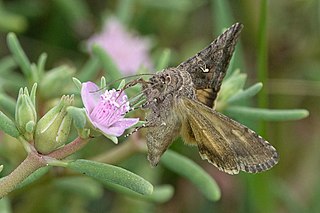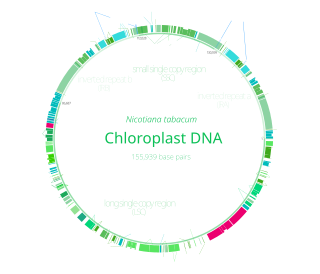
Nicotiana is a genus of herbaceous plants and shrubs in the family Solanaceae, that is indigenous to the Americas, Australia, Southwestern Africa and the South Pacific. Various Nicotiana species, commonly referred to as tobacco plants, are cultivated as ornamental garden plants. N. tabacum is grown worldwide for the cultivation of tobacco leaves used for manufacturing and producing tobacco products, including cigars, cigarillos, cigarettes, chewing tobacco, dipping tobacco, snuff, and snus.

Agrobacterium is a genus of Gram-negative bacteria established by H. J. Conn that uses horizontal gene transfer to cause tumors in plants. Agrobacterium tumefaciens is the most commonly studied species in this genus. Agrobacterium is well known for its ability to transfer DNA between itself and plants, and for this reason it has become an important tool for genetic engineering.

Nicotiana glauca is a species of flowering plant in the tobacco genus Nicotiana of the nightshade family Solanaceae. It is known by the common name tree tobacco. Its leaves are attached to the stalk by petioles, and its leaves and stems are neither pubescent nor sticky like Nicotiana tabacum. It resembles Cestrum parqui but differs in the form of leaves and fusion of the outer floral parts. It grows to heights of more than two meters.

Nicotiana sylvestris is a species of flowering plant in the nightshade family Solanaceae, known by the common names woodland tobacco, flowering tobacco, and South American tobacco. It is a biennial or short-lived perennial plant in the tobacco genus Nicotiana, native to the Andes region in Argentina and Bolivia, in South America.

Nicotiana rustica, commonly known as Aztec tobacco or strong tobacco, is a rainforest plant in the family Solanaceae native to South America. It is a very potent variety of tobacco, containing up to nine times more nicotine than common species of Nicotiana such as Nicotiana tabacum. More specifically, N. rustica leaves have a nicotine content as high as 9%, whereas N. tabacum leaves contain about 1 to 3%. The high concentration of nicotine in its leaves makes it useful for producing pesticides, and it has a wide variety of uses specific to cultures around the world. However, N. rustica is no longer cultivated in North America, as N. tabacum has replaced it.

Nicotiana benthamiana, colloquially known as benth or benthi, is a species of Nicotiana indigenous to Australia. It is a close relative of tobacco.

Nicotiana tabacum, or cultivated tobacco, is an annually grown herbaceous plant of the genus Nicotiana. N. tabacum is the most commonly grown species in the genus Nicotiana, as the plant's leaves are commercially harvested to be processed into tobacco for human use. The plant is tropical in origin, is commonly grown throughout the world, and is often found in cultivation. It grows to heights between 1 and 2 meters. Research is ongoing into its ancestry among wild Nicotiana species, but it is believed to be a hybrid of Nicotiana sylvestris, N. tomentosiformis, and possibly N. otophora.

Anabasine is a pyridine and piperidine alkaloid found in the tree tobacco plant, as well as in tree tobacco's close relative the common tobacco plant. It is a structural isomer of, and chemically similar to, nicotine. Its principal (historical) industrial use is as an insecticide.

A transplastomic plant is a genetically modified plant in which genes are inactivated, modified or new foreign genes are inserted into the DNA of plastids like the chloroplast instead of nuclear DNA.
Asparagus virus 1 (AV-1) is one of the nine known viruses that infects asparagus plants. It is a member of the genus Potyvirus in the family Potyviridae. Initially reported by G. L Hein in 1960, it causes no distinct symptoms in asparagus plants. The only known natural plant host is the asparagus. It is spread by aphid vectors, which means that aphids do not cause the AV-1, but they do spread it.
Nicotiana tomentosiformis is a perennial herbaceous plant. It is a wild species of tobacco native to the Yungas Valley region in the eastern piedmont of the Andes Mountains, primarily in Bolivia.

Rachiplusia nu is a species of moth in the family Noctuidae. It is found in South America, including Paraguay, Uruguay, southern Brazil, Argentina and Chile.

Chloroplast DNA (cpDNA) is the DNA located in chloroplasts, which are photosynthetic organelles located within the cells of some eukaryotic organisms. Chloroplasts, like other types of plastid, contain a genome separate from that in the cell nucleus. The existence of chloroplast DNA was identified biochemically in 1959, and confirmed by electron microscopy in 1962. The discoveries that the chloroplast contains ribosomes and performs protein synthesis revealed that the chloroplast is genetically semi-autonomous. The first complete chloroplast genome sequences were published in 1986, Nicotiana tabacum (tobacco) by Sugiura and colleagues and Marchantia polymorpha (liverwort) by Ozeki et al. Since then, a great number of chloroplast DNAs from various species have been sequenced.

The Solanaceae, or the nightshades, are a family of flowering plants that ranges from annual and perennial herbs to vines, lianas, epiphytes, shrubs, and trees, and includes a number of agricultural crops, medicinal plants, spices, weeds, and ornamentals. Many members of the family contain potent alkaloids, and some are highly toxic, but many—including tomatoes, potatoes, eggplant, bell, and chili peppers—are used as food. The family belongs to the order Solanales, in the asterid group and class Magnoliopsida (dicotyledons). The Solanaceae consists of about 98 genera and some 2,700 species, with a great diversity of habitats, morphology and ecology.
Roy Elwood Clausen was a biochemist, botanist, plant geneticist, and drosophilist.

Pal Maliga is a plant molecular biologist. He is Distinguished Professor of Plant Biology and Laboratory Director at the Waksman Institute of Microbiology, Rutgers University. He is known for developing the technology of chloroplast genome engineering in land plants and its applications in basic science and biotechnology.

Nicotiana paniculata, the small-flowered tobacco, is a species of flowering plant in the family Solanaceae, native to western Peru, and introduced to the Canary Islands. It is a parent of the economically important species Nicotiana rustica.

Nicotiana forsteri is a species of wild tobacco in the family Solanaceae, native to Queensland, New South Wales, Lord Howe Island, and New Caledonia. It is a tetraploid.














